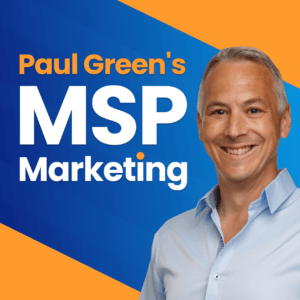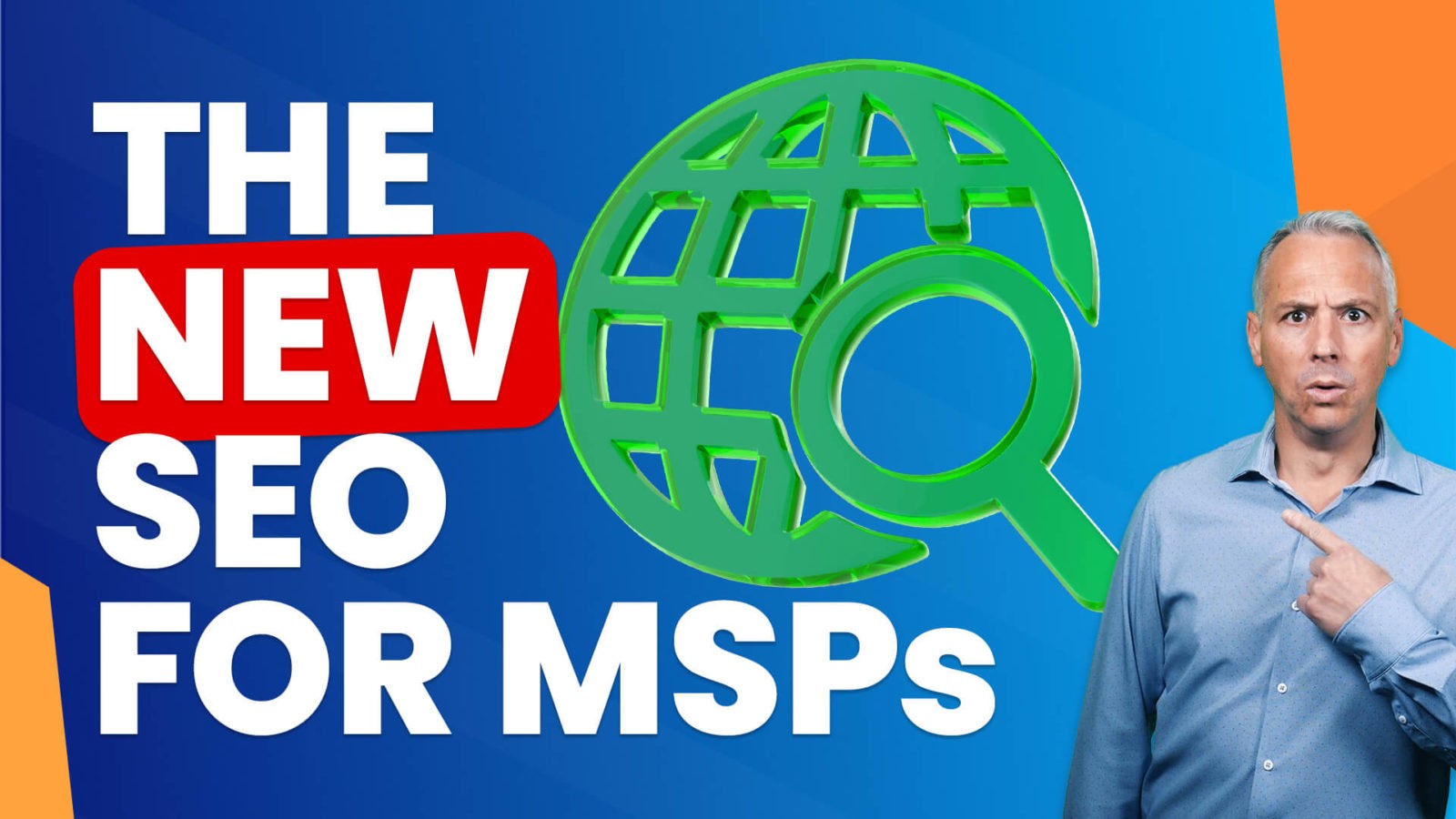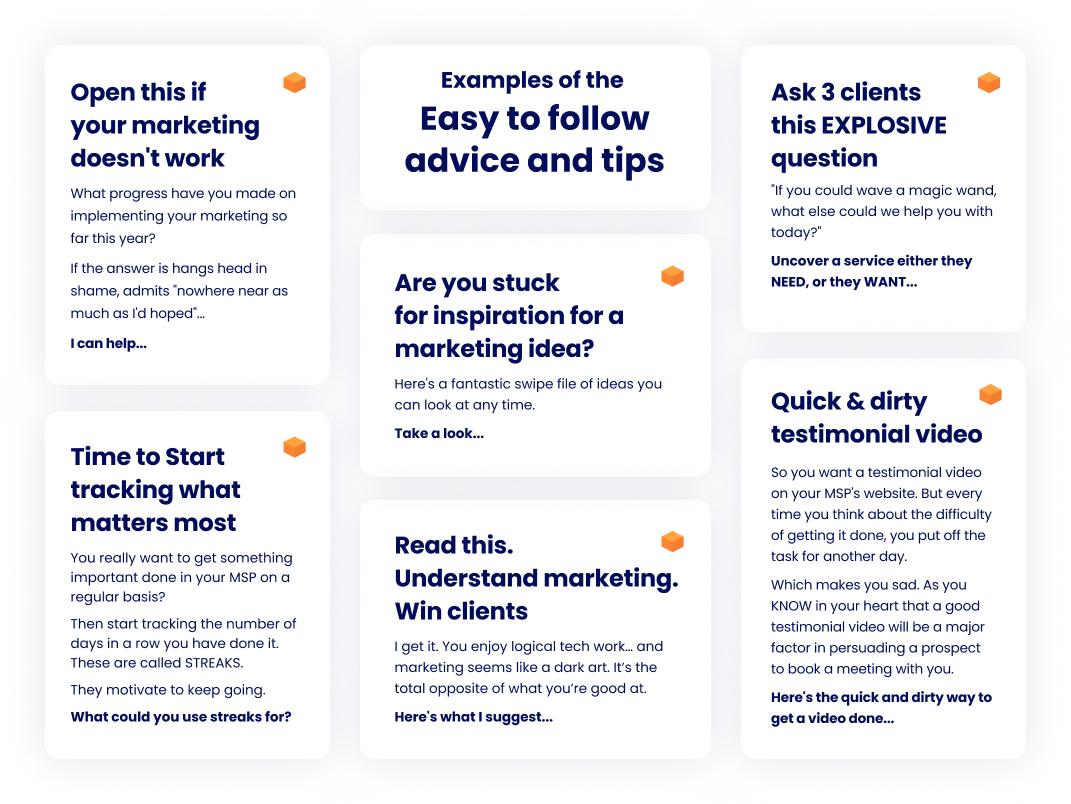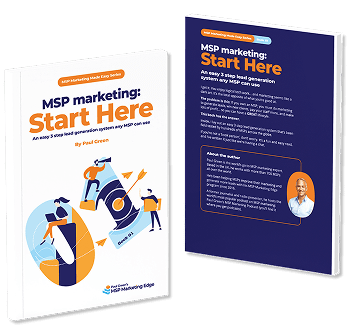
The podcast powered by the MSP Marketing Edge
Welcome to Episode 286 of the MSP Marketing Podcast with me, Paul Green. This week…
- How to get your MSP recommended by ChatGPT: Ordinary people don’t just use Google for search anymore, many searches are being done using generative AI platforms. Are you ready to find out about GEO and how to leverage it for your MSP?
- 3 marketing priorities for your MSP in May: Want to do something to speed up your MSP’s growth as we near the middle of the year? Here’s some marketing ideas for May.
- 99% of MSPs do no proactive client retention: MSPs generally hold on to clients long-term, but not necessarily by design. My guest tells us why we should build an “intentional” retention programme to help improve customer experience and drive growth.
- Paul’s Personal Peer Group: Would your MSP survive without you for 3 months? Find out how you can prepare your business in the event of your absence.
How to get your MSP recommended by ChatGPT
I’ll admit this could be a contradiction. You need to market your MSP so you can find new clients, and no doubt you want to hear about specific tactics that are going to work for you. Now, normally my advice is to ignore shiny new things because most of the time they’re just unproven ideas and a complete waste of time. But this really is different. Have you heard about the tactic that could be huge for early adopters? Are you ready to find out about GEO, the evolution of SEO? Find out about the huge potential for MSPs, what the main advantage is and why you can’t afford to ignore this day one alert.
More and more MSPs are starting to wake up to the fact that ordinary people don’t just use Google for search anymore. There are no hard stats about how many searches are being done using ChatGPT and other generative AI platforms. There are certainly lots of predictions that traditional search traffic will be down by 25% by the end of next year, but even without hard figures, there are times where a generative AI search does produce more useful results than a traditional Google search.
Google is still great for looking up something quick, but generative AI is great for doing research into something complicated that you don’t really understand.
And if we look at managed services from the point of view of ordinary decision makers, well that’s something complicated that they don’t really understand. Do we think it’s possible that business owners and managers are already using generative AI to research which MSPs they should switch to in their marketplace?
If they’re not doing that already, then they’re certainly going to do it in the very near future. And this is where you have an opportunity to get into something right at the beginning. You see, just as the rise of search engines saw the birth of SEO, search engine optimisation, so the rise of generative AI has seen the birth of GEO, generative engine optimisation. It’s designed to help your website appear in the research results output by generative AI.
Now, I’ve been reading a ton about this in the last few weeks, and there are three simple things that you can do to your website today, which will help to give the generative AI platforms answers. And if you can give them answers about your MSP, they’re much more likely to recommend you to people asking them which MSP should they look at.
The first is to make your website crystal clear about what you do, how you help, and what makes you different. But crucially, this must be written in plain English. So here’s an example: We help businesses in your city save money and be more efficient with technology. That line or your version of it, well it needs to go on your website. And the good news is that in this instance, what’s good for generative AI is good for humans as well. The more easily they can understand what you do and who you do it for, the more likely they are to start a conversation with you.
The second simple thing you can do then is kind of similar to SEO, and that’s to get your MSP business mentioned across as many trustworthy websites as possible. In SEO, you are trying to get links back to your website In GEO, you just want references to your business and obviously getting a reference and a link in one package will be fantastic. The generative AI platforms are looking for evidence that yours is a business that should be spoken to. So if you are being talked about by other people, that gives them really high levels of confidence that you are trustworthy.

And then the final thing you can do is ask for detailed positive reviews everywhere you can, but especially on YouTube. AI tools are looking everywhere for reviews and again, it’s part of them cross-referencing to see which of the best MSPs to speak to. For a long time now, YouTube has been a place where people go to find wisdom and you can help demonstrate this wisdom by having your clients talking about you on camera, on YouTube. And of course once it’s on YouTube, then again it’s helping to persuade the humans. You can embed it into your website, you can turn it into written case studies, you can do all sorts of things with it.
So there are three simple things you can do to get started with your GEO. And if you go off and do your own research, you will discover lots more things out there you could do. But let me just caveat that up, this is very much day one, well, in fact it’s hour one of day one for GEO. So a lot of those clever little tricks that you’ll see reported across the internet that might not be good long-term strategies. The three things I’ve just spoken about there, they are three good solid basics to help generative AI platforms to understand what you do, who you do it for, and why you can be trusted. And that’s why I think you should implement these three things as quickly as you can.
Alright, there’s every chance I’m going to put my foot in it.
There you are happily and hungrily trying to run and grow your MSP and there’s nothing more annoying than someone suddenly reminding you where you are in the calendar and the fact that time’s passing faster than Superman late for work.
So yeah, it’s nearly the middle of the year already and yes, it was Christmas just yesterday, but don’t get stressed. Are you ready for something that’s going to speed up your MSP’s growth?
Let’s talk MSP marketing in the month of May.
3 priorities to help you wrestle back control of your time, change your way of thinking, and grow faster for the rest of this year.
Number one, stop selling to people and start building a relationship with them instead. Everyone hates being sold to and yet we love to buy. Most buying decisions are made by the heart and not the brain. And yes, that especially means B2B decisions such as which IT support company to use. The worst way you can sell your business is to be kind of like a photocopier salesperson, and you know what I mean by that, right? No one trusts photocopier salespeople, even if they exist these days, but it’s why our hearts sink when we meet them. Instead, you should aim to become a trusted advisor.
Most people who buy managed services don’t know what they don’t know. And as they realise this and become conscious incompetents, they seek out people to educate them, guide them, and help them. If your business can provide that education, guidance and help, you stand an exceptionally good chance of picking up their business at the point that they are ready to buy.
The way to do this is through a well thought through educational lead generation system. You find out who’s in the market for buying IT support or consultancy. You get them to tell you who they are and give you their permission to market to them. And then you teach them how to buy from you. You are there in front of them at exactly the moment that they are ready to buy. And for some people this is days after they meet you, for others the most, this is years and of course there’s everything in between.
Number two, start using 80/20 thinking about prospects and clients. Clients are not made equally. You’ve probably noticed that most of your hassle and stress comes from a very small number of your clients, and it’s the same with profit, right? You get the most profit from the smallest number of clients.
And then finally number three, and it’s kind of along the same themes, which is to sell more to your existing clients. One of the best retention tools you have is to increase the amount of stuff that people buy from you. And your staff may consider that the less people have to buy, the happier they’ll be but that’s slightly twisted thinking. We buy things in two ways, stuff that we need with our brains, stuff that we want with our hearts. And the challenge is to get your clients focused less on what they need and more on what they want. People who buy more of what they want are typically happier, better retained clients. So it needs to become habitual within your business to tell people everything that you can do for them in a way that’s not overwhelming. Tell them everything that could be done. Let them decide what it is they want to buy.
99% of MSPs do no proactive client retention

Featured guest: Melissa Hockenberry, owner of First Things First Training and Consulting, is passionate about improving customer and revenue retention. Her 30-year professional journey includes adventures in Fortune 500 and non-profit, as well as over 18 years with Autotask/Datto. Melissa loves engaging with MSPs to help them improve their customer experience and position them for sustainable growth.
Guilty secret time. A lot of MSPs will admit to holding onto long-term clients, but not by design. It just kind of happens that way. If this is you, do you not feel this guilty secret is also a dangerous one? In which case you need to hear it from my special guest today. New clients are great, but if the majority of your earning potential comes from keeping and upselling your current clients, you’ve got to check this out. How do you remove the risk of losing your clients? How do you make it an easy system? And how will your MSP benefit? Let’s find out.
Hi, I’m Melissa Hockenberry, founder of First Things First training and consulting,
And it’s amazing to have you here on the podcast, Melissa, thank you so much for joining me. We are going to talk about one of the most important aspects of marketing an MSP that actually kind of gets forgotten, and that’s retention. I think most MSPs have insane retention built into their business, but I don’t think many of them realise that some of that retention is down to something called “inertia loyalty”, where it just feels too hard for the customer to leave this MSP to go over to that MSP. So while most MSPs do enjoy that retention, they perhaps don’t understand why they’ve got that retention and maybe don’t even have a system or a strategy to focus and actually bake retention into the product. So that’s what we’re going to talk about today. Let’s first of all look back at your career and what you’ve done because you’ve been in the channel for a very long time haven’t you?
I have, I want to say I started at 10, but that’s not true. So I’ve been in the channel since 2004. I started with Autotask, and was with Autotask that became Datto that became Kaseya, for 18 and a half years and started out on my own business in February ‘23.
Amazing. And what was it that made you, I mean, that’s a very long time to survive what was I guess a small, quite focused team right at the beginning, up to being one of the biggest vendors in the channel. Well, let’s talk about that journey before we talk about what made you leave. So what was that like staying through those amazing transformation years?
It was phenomenal. As a student of business, my undergraduate was in marketing and business, and I got my MBA in my early stages of Autotask. It was phenomenal to have that experience. I started as the first dedicated product support rep at Autotask and got the first promotion, was the first person to go remote. It was just a lot of fun in that there were nine of us when I started. I think there was a group of five that were hired on the same day. And just to watch it grow and see that and be in almost a case study as it happened, was kind of cool. What made it feasible? Honestly, when I look back on it, I’m sure there are people like, Why would you stay in one company for 18 years? Well, I had 10 different jobs. I was constantly being promoted to the new thing or in charge of the new thing, but eight of those 10 times the job didn’t exist prior to me doing it.
So that made it the type of thing I loved doing, because you were basically just forging your own step forward. And I was given a lot of leeway to, go interpret this and do this how you think it should be done. And that made it very easy. And what I liked actually is most people can’t say they like mergers and acquisitions, but it was cool for me when we would acquire a company. One of them happened to be in Denmark and I had studied there for four months. So it was fun to know the culture of that company. It was also interesting when we were merged or acquired because I was lucky enough to be in a position where I was often dumped over enemy lines. I was often one of the first people to go work with the other group, and they were always amazing people.
And so even though I was there 18 and a half years, and man, that’s a long time. It never felt like that. It felt very new all along. And when Datto and Autotask merged, that was a really cool point because I think at that point I’d been there, I guess it was about 13 years or so and probably at the point where I was getting sort of like, I should try something different. And the cultures were very different so it really did feel like I started working for a new company and within six months I didn’t work with any of the peers I had worked with before. I was totally submerged in a Datto or a new employee group. So it was really fun. It was a lot of fun.
What an amazing story. And I can completely see how, yeah, it’s not really 18 years with the same business at all. You did eight different things, eight totally different things there. What was it that made you finally decide to leave a couple of years ago and go and do your own thing?
Some people would call it a midlife crisis. I was in my late forties and sort of turned to my daughter on my birthday and said, I’m not going to be doing this same thing and not for the same company a year from now. And honestly, I’m a very faith-based person. So in prayer, I really felt like it was time for me to jump out and start to use what I had learned in a much bigger arena, be able to have impact of everything I had learned over the years and get it to more people because you’ve sort of sequestered in a company. I will say I was never a person that was like, I want to be an entrepreneur. Never. I love a W2. I love a steady paycheck, I love all those things that come with it, but I felt very much like it was time to go do that. And I’ll say, I said one last prayer on Sunday, April 10th, and if you look back in the logs of Sunday, April 10th, 2022 on Monday, April 11th, Kaseya purchased Datto. And so people say that it was that kind of that final sign for me that, okay, it’s time to go. And the people I worked with at Kaseya were wonderful people as well, and I had a great team that I was pulled into there as well. But it was definitely time to go and it was perfect. Perfect timing for me.
It was you, you did this with your prayer, you made this happen. All this consolidation. Just out of interest, how old was your daughter at the point you decided to leave Kaseya?
That’s a great question, in that something I tend to leave out was that when my daughter was four Autotask had actually eliminated my position. I was doing proactive work. I was doing retention work in all sincerity, and they’re like, we really need to do this other reactive work. And so I stayed in, because I live in the remote area of Pennsylvania and it’s hard finding another job. But my daughter at the time, at four, when I wasn’t sure if I was going to stay or go, she said, Mom, you love your customers too much. You can’t go. Well, fast forward a decade later, and I have a 14-year-old who is coming into an expensive time in her life and I decide to cut our income in half. But I think I will see that she’ll remember budgets more, she also will remember that her mom who was over 50 when I did this, took on a brand new life adventure at 50. And I think, I hope that speaks more volumes than she actually had to pay for her white leather Converse that I said were too expensive.
But yeah, she’s been great, I will sometimes have trouble thinking through an idea and I’ll just go to her and she is a great sounding board, so I’m very thankful exactly how it happened. I think it was perfect timing.
Yeah, that’s amazing. It’s amazing story. And I have a 14-year-old as well. I appreciate your daughter’s a few years on now, but the greatest thing about having a teenager is when you’ve got a business problem, of course, teenagers are always right. So any question you just ask them and they give you the perfect answer, which is fantastic. So thank you teenagers.
And if you become a little too ego driven, they will cut you down in less than 15 words.
Oh yes, yes, absolutely. I drive her to school in the mornings and it’s like a 20 minute journey and she can go through all the range of emotions and I can be the best human being at the start of the 20 minutes and the worst at the end. Anyway. Let’s not talk about our children. Let’s talk about retention. So the thing I said right at the beginning, which is maybe a slightly provocative thing, is that MSPs have great retention and assume that it’s because they offer a great service, yet I believe not all, but many of them have great retention because their customers are staying through inertia loyalty. It feels easier to stay than to move to another MSP. In fact, that inertia loyalty is a double-edged sword. It keeps your clients with you for years and years, but it’s what makes it harder for you to win new clients and wrestle them away from other MSPs. So is this your experience as well that MSPs don’t really take retention seriously?
100% and actually I have a video on that discussion right now because people think, I have never lost a customer. And I will say, That doesn’t mean you have a retention plan. You have to be intentional about this.
Even if you’ve never lost a customer, but you don’t know why they stay, that’s a great indicator that you don’t have a retention plan.
Because you don’t know why your customers are still with you, right? Oh, they just are. That’s wonderful. I hope you don’t take the same approach to your marriage, right? Oh, they just stay. It’s a great phrase. The loyalty and your 100% correct. MSPs don’t always have the customer viewpoint, they just have the technology. And they want to get done and they want to deploy it and do it quickly, and that doesn’t always give the greatest experience. And so they do have trouble, they bring a lot of people in the front door and then somebody told me the other day that a lot run out the back. That’s what you’ve got to understand. So I’ve always been hyper aware of the customer view. I like to call them goggles, I’m a swim mom, so putting on the customer goggles, which are a little uncomfortable at first if you’ve ever swam, but it’s one of those things that you need it for clarity, and that’s what I’m hoping to help MSPs build before they make a change, understanding what impact that’s going to have, understanding why people do stay with them so that they don’t make a change that is detrimental to that loyalty.
So let’s talk about putting on those customer goggles, and I love that concept. If you are working with an MSP, well, let’s take the average MSP that listens to this podcast. So it’s typically business owner or manager. They’ve got, maybe 3, 4, 5 techs. They could be a one person band, they could have some techs, it could be bigger. But if we assume that they’re not doing anything proactively for retention, so it’s something they’ve intended to get round to in 2023 and ‘24 now in ‘25, and it’s now back on their radar again, where do you even start? What are some of the practical things that you should do? Should you look at what kind of customers you’ve got? Should you be doing analysis? Should you be talking to them? What’s the best way to get started?
I think the easiest is to get your house in order first. And there’s some things that people don’t think about. So first of all is job descriptions. It seems very strange for retention, but job descriptions will let you know who’s focusing on what. And I can’t tell you the number of MSPs probably sitting right down and going, oh yeah, I never finished that person’s job description. Now you’ve hired three people and they still don’t have a solid job description. But for the purpose of the fact that if you are a one to 3, 4, 5 person shop, you need that job description so that everywhere in that description, it talks about focusing on a positive experience for the customer so that when you have somebody who doesn’t do that, you have grounds now to say you’re not meeting the job description. So solid job descriptions are a part of retention because your people are going to help you retain.
They’re your first line of defence and retaining. If it’s just you, okay, where do I get started? You get started with a concerted effort to start listening to your clients. There’s a phrase that I love and everybody knows it will go in my obituary, What questions do you have? So you’re a one person show and you have just poured out everything to a client instead of, do you have any questions? What questions do you have? You are going to find clients who never asked a question are asking six questions after you say that, because you just open up the conversation and now you’re starting to learn more about them. So as a one person shop, I’d say, go deeper and understanding the clients that you do have, and when you have a chance, go to lunch and say to them, Hey, why are you still with us? What makes us work for you? Have you figured that out? Have you ever thought about that? Having that casual relationship conversation, but two phrases, What questions do you have? And, Tell me more. They’re very powerful phrase in learning and understanding. So if you’re a one person, I go there, if you’re more than one person, I’d start with your job descriptions and I’d start with your documentation of how you interact with your clients so you have consistency. So those are the tools towards retention. If you’re beyond that, then we talk about surveys, listening posts, those kind of things.
Okay, well, let’s come back on surveys and listening posts in a second. You just said something which as a fellow business owner struck fear straight into my heart, which was, Why are you still with us? Because, I’ve got 700 MSPs that I’m working with right now, and I would be terrified to ask them that because I think as a business owner, it’s not a business, it’s a personal thing, isn’t it? It’s a baby. It’s another child. I have two children really. I have my daughter Samm, and I have the MSP Marketing Edge. Those are my two children. And as much as I would be confident asking that question, there would be a deep fear. It’d be like asking a wife or a husband or a partner, why are you still with me? Maybe we’d be a bit more confident with that because it’s a one-on-one relationship. Do you find with the MSPs that you work with, that they are also terrified to ask that question? Whether it’s those words or whether it’s slightly different words? And if that is the case, how do you help them to have the confidence to directly ask and to find out why someone is sticking with them?
I think yes, there are some people where a lot of their clients are personal connections, which I think there’s a danger in that too, which if we have time we can get back to that, but they don’t have a problem with asking that. But for those that have a problem, I think the big thing is always being able to put the business in front of yourself. Yes, it is you, you and the business are one thing, but understanding that you can only improve if you’re asking for feedback or I love the Daniel Pink statement of ask for advice. Maybe it’s easier to start with, What could we have done better in this situation for you? Even if it looks like it went well, what could have gone better or what could we have done better or give a specific thing.
I can kind of weave surveys in here a little bit because some of the things that people do with surveys, which are wrong, is they’ll take a hundred clients and send them a survey, and what if you get 15 that hate you from that? How are you going to get back to them within a business day? You need to think about what if they don’t like me? So if you’re starting surveying, I think that’s a good way because at least that gives, if you’re not doing any of that, at least that’s kind of a third party way to get in there. But remember, most people who are really upset don’t always answer a survey, there are just survey people. So you need to get to your client, you need to get in person and have that conversation. And maybe it’s just going out and having lunch or bringing donuts to their office and just being around the water cooler and just saying to them like, Hey, how are things going for you? And because every MSP should be not looking just to talk about technology, but they should be looking to talk about strategy. And then those can be bigger questions and you start to build it’s build relationship. I have a statement that says, relationships build retention and retention builds revenue. So you start with just building relationships and then the questions that are sometimes difficult come a little bit easier after that.
Yeah, I love that. So my takeaways from that, you’re right, Daniel Pink’s question of, Can I ask for some advice?, which is essentially saying, can I have some feedback? But without using the F word, the feedback word. And I see surveys as a lazy way of doing it, and I know when you’ve got thousands of clients, if you’re a big company with thousands of clients, it’s the only way. But the reason I think it’s lazy is because exactly as you, Melissa, they’re are survey people. I’m not a survey person. Whenever I get a survey, if I can press a button like a customer thermometer feedback, happy face, I’ll do that. But not the, This will only take you 15 minutes, methodology – NPS standing for net promoter score. Go and Google it if you’re listening to this and you don’t know. But to me you are only ever going to get a subsection of people. I always think the greatest value comes from talking to people.
We did a massive project two years ago to completely revolutionise and update and change how we delivered what we do for our members. And I spent not inconsiderable amount of money paying a researcher to do a hundred zoom interviews. So she interviewed a hundred of our members, more or less a hundred over Zoom, and we’re talking like 20, 20, 25 minute conversations, we’re not talking quick conversations. But the value that we got from that was a thousand times what we paid. And even today, we can run a decision past the research. What did members say two years ago that would influence how we’re doing that now? Which was just such a valuable conversation.
Melissa, I could talk for hours and hours to you about this, and you are going to be one of these perennial guests that comes back onto the show. I can feel it in my bones. Let me ask you a final question. It was something you mentioned earlier, and then we’ll talk about what you do to help MSPs. So you said you threw a little side out about how clients become personal connections and there’s a danger in that. Can you explain that to us?
Yeah, so just like a marriage that’s 25 years old, which I have one of those, you have a complacency and a comfort. And I’ve heard more MSPs in the last year or so say to me, I lost a client and they were like a personal friend, these are people I knew well. I was just on a call with some customer success managers, a peer group that I moderate, and we were talking about, what do you do when you don’t have anything to talk about with a client? I’m like, well, you still go. You take them donuts. You ask bigger questions. Because very quickly, especially when so many of these customer success people are so overwhelmed with way too many clients, you forget that it’s been four months since we’ve been there, or it’s been three QBR since I’ve been there, so we’re talking nearly a year. So I think that when you get comfortable with someone, you think, oh, they’re never going to leave, but you’ve lost attention to them. So I think you always have to take that person and say, yep, we have a good relationship, all the more reason I should want to go and hang out with them and ask them what their strategy is.
I always say, if you do not know the business goals, not the technical goals, the business goals of your top 10% of your customers, or top 10, however you want to take that, but what is that 80% revenue mark? If you don’t know the business goals, you’re at risk of losing them because you are not entwined with what they’re doing. And don’t let the technology filter come onto those business goals, but go and have that business discussion. I can guarantee you, even if you don’t have anything to talk about, they had something come up that was major in their business in the last quarter, go ask them about it and see if you could have helped. If nothing else, you can be a listening ear, and that’s going to build reputation and relationship and renew your commitment to them, even if they’ve been a 15 year fan or a 20 year friend.

Yeah, I completely agree. And in fact, this is where MSPs are putting a foot into the VCIO territory, and I think the concept of VCIO has been shaped into something else within the MSP world. It’s not strictly as it should be, but if you do strategic reviews with people, if you build technology roadmaps and you are taking a three year view, where you are looking at their business through the filter of technology, but it’s not the technology you’re looking at, you’re looking at where they’re going, how they’re going to get there, and we all know that technology plays an integral part, but it’s not the be all and end all. It’s the enabler. And I think you’re right to look at it that way. So you never stop giving value, as it were. Melissa, thank you so much for your time. Let’s just briefly talk about what do you do. So obviously we all know now that you started your own business a couple of years ago. You’re working with a load of MSPs. Tell us what you do to help MSPs and what’s the best way to get in touch with you?
When I help them I start with something as simple as a customer retention inventory, which you can actually find on my website. My website is the first letter of each one of the words in my company, which I should have thought of differently, but it’s FTFTAC.com, tried to make it short, but those all sound like the exact same thing. So if you think First Things First Training And Consulting, you’ll get there, just take the first letter and smash them together. You can also follow me, find me on LinkedIn, that’s where I post all of my information.
I’m helping managed service providers really take a look at what are their current retention efforts and where can we get them to a bonafide retention programme. And I’m all about the baby steps of it. So even if you’re like, well, I don’t even know yet, there’s portions of what I’m doing that you can still find value with. I give a free webinar every month, take a look. You find it on LinkedIn that talks about inventorying your customer retention efforts. So take a look and see how you are doing, where are you, and then we move through the process from there. So it’s all about building a retention programme, an intentional retention programme, not just a, I’ve never lost a customer retention programme.
Paul’s Personal Peer Group
Colin runs his MSP in Maine, and he’s considering contingency plans. One of his business owning friends recently got ill and had to take an unexpected sabbatical from his business, so his question is: How can I prepare my business so it’ll not be affected if that happens to me?
Let’s make that less about scary illness, more about being prepared for anything. Imagine that tomorrow morning I decided to swap a career in marketing for a thrilling life of crime, and I kidnapped you. And don’t worry, I’m going to look after you. I’m going to cook for you every day, I can cook quite well, and I do have all the streaming platforms; you’re going to have a great time as my kidnap victim. But ultimately, I keep you locked up for the next three months.
So put another way, your staff and your clients won’t be able to reach you at all for the next three months with no notice. So the big question is this, what happens to your MSP? Does it thrive or does it just survive? Or after three months, would you tell me to keep the door padlocked and keep you here as there’s no business to return to? And anyway, you like my pasta bake?
This is a three month stress test, and it determines how well the business will do if you are unexpectedly removed from it for a long period of time. And all businesses can do okay just fine without the owner for a week or two. It’s when it becomes long-term. That’s when the inherent flaws show up. Who would naturally take charge? How likely are they to make decisions? How well supported would they be? Would they know to reach out to your professional advisors for support? Where would they go for senior tech advice and guidance? Could they deal with an angry client? Often it’s the little things that cause the biggest problems. Can someone access the bank account to pay staff and suppliers? Can someone access your email if yours is the master email for key vendor password resets? Do they know how to contact the landlord if there’s a problem with the office?
All businesses would struggle to a certain degree with the unexpected temporary removal of the owner. So one of your key jobs as the leader is to ensure that everything you do is clearly documented and appropriate emergency access measures are put in place, such as activating the emergency kit that’s found in many password managers.
Mentioned links
- This podcast is in conjunction with the MSP Marketing Edge, the world’s leading white label content marketing and growth training subscription.
- Join me in MSP Marketing Facebook group.
- Connect with me on LinkedIn.
- Connect with my guest, Melissa Hockenberry on LinkedIn, and visit her website First Things First.
- Got a question about your MSP’s marketing? Submit one here for Paul’s Personal Peer Group.


